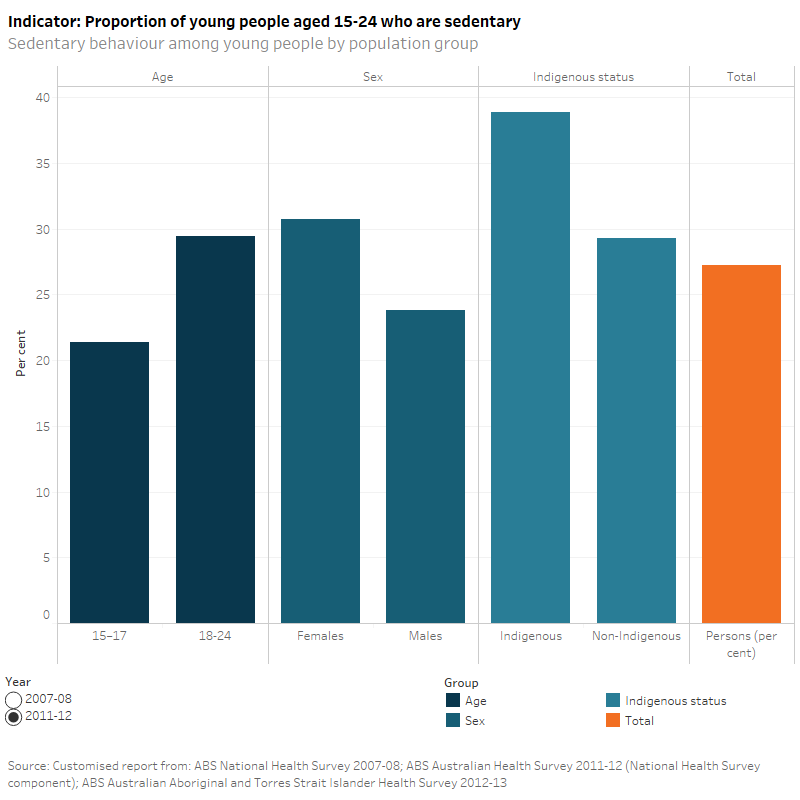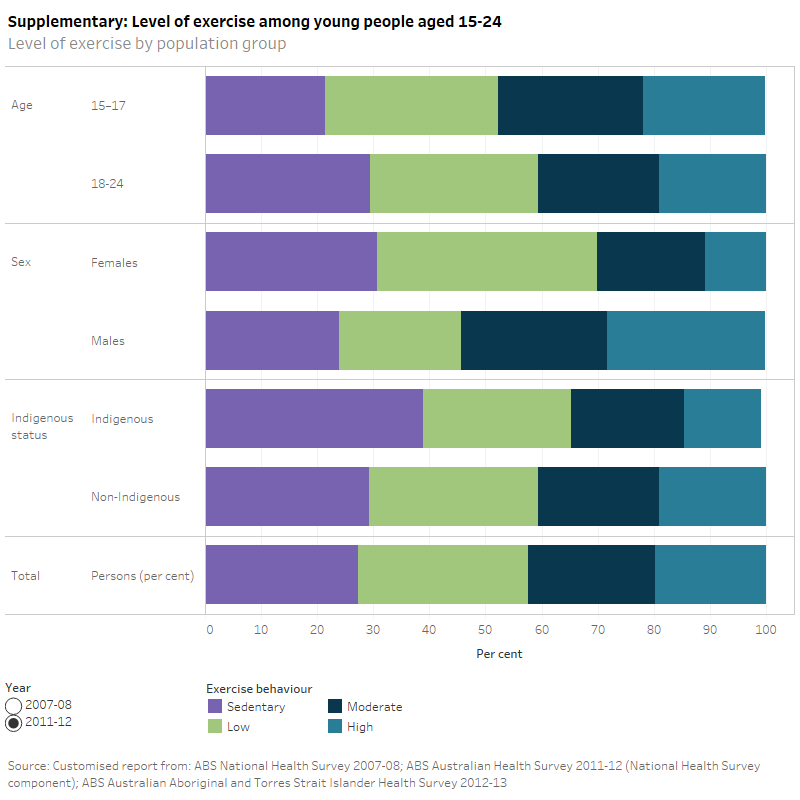Level of physical exercise
Why is reporting on physical activity important?
The importance of regular physical activity to the health and wellbeing of young people is well established (Brown et al. 2013). Physical activity is known to reduce risk of cardiovascular disease and also positively affects cardiovascular risk factors such as overweight or obesity, high blood pressure and Type 2 diabetes (AIHW 2015). It protects against some forms of cancer, and strengthens the musculoskeletal system (AIHW 2014; Okely et al. 2012). Physical activity may also improve an adolescent’s psychosocial wellbeing by reducing symptoms of depression, stress and anxiety, and through improvements in self-confidence, self esteem, energy levels, sleep quality and ability to concentrate (Okely et al. 2012).
The ABS Australian Health Survey categorises physical exercise into four levels: high, moderate, low and sedentary (no exercise or very low levels of exercise) (ABS 2013). The sedentary level represents individuals who may particularly benefit from increased levels of exercise.
Do activity levels vary across population groups?
In 2011–12 more than 1 in 4 young people aged 12–24 years were sedentary (27%), and levels of sedentary behaviour rose with increasing age (21% of 15–17 year olds and 29% of 18–24 year olds). Females were more likely to be sedentary than males with 31% and 24%, respectively. Similarly, Indigenous young people were more likely to be sedentary than non-Indigenous young people (39% compared to 29%).
There were significant differences in each level of physical exercise between males and females. Females had higher proportions of low-level physical exercise than males (39% compared to 22%). Conversely, males were more likely to have moderate (26% compared to 19%) or high levels (28% compared to 11%) of physical exercise than females. A significantly higher proportion of non-Indigenous young people had high levels of physical exercise compared with Indigenous young people (19% and 14%, respectively).
Has there been a change over time?
The ABS Australian Health Survey 2011–12 showed that in the 4 years since the previous survey there was a significant reduction in the proportion of all young people reporting sedentary behaviour, from 33% to 27%. This decline was consistent among the different population groups examined, however, the only statistically significant reductions over this period were for 18–24 year olds (36% to 29%) and males (30% to 24%).


This report is based on survey data; relative standard errors and 95% confidence intervals are provided in the Source data tables: NYIF indicators. Significance testing was undertaken on values cited in the text; unless otherwise stated, differences were found to be statistically significant.
In the ABS Australian Health Survey 2011–12 exercise levels for respondents 15 years and over were defined based on an exercise score and associated categories relating to this score (ABS 2013). The survey collected frequency and intensity of exercise for fitness recreation or sport in the week prior to the interview. An exercise score was derived by multiplying factors to represent the intensity of the exercise (3.5 for walking, 5.0 for moderate exercise and 7.5 for vigorous exercise) by the duration of physical activity in minutes (ABS 2013). Scores were grouped into the following 4 categories (ABS 2013):
Sedentary—Scores less than 50 (includes no exercise)
Low—Scores of 50 to less than 800
Moderate—Scores of 800 to 1600, or more than 1600 but less than 1 hour vigorous physical activity
High—Scores more than 1600 and with 1 hours or more of vigorous exercise
The ABS National Health Survey 2007–08 collected information on exercise engaged in during the two weeks prior to interview (as opposed to the week prior to interview). The scores provided above have taken into account these differences.
Customised report from: ABS National Health Survey 2007–08; ABS Australian Health Survey 2011–12 (National Health Survey component); ABS Australian Aboriginal and Torres Strait Islander Health Survey 2012–13
Data quality statement: Not available, please see ABS Australian Health Survey 2011–13 for further information
Australian Bureau of Statistics (ABS) 2013. Australian Health Survey: Users’ Guide, 2011–13. Adult Physical Activity. Cat. no. 4363.0.55.001. Canberra: ABS
Australian Institute of Health and Welfare (AIHW) 2014. Australia’s health 2014. Australia’s health series no. 14. Cat. no. AUS 178. Canberra: AIHW.
AIHW 2015. Cardiovascular disease, diabetes and chronic kidney disease—Australian facts: Risk factors. Cardiovascular, diabetes and chronic kidney disease series no. 4. Cat. no. CDK 4. Canberra: AIHW.
Brown W, Bauman A, Bull F, Burton N 2013. Development of evidence-based physical activity recommendations for adults (18—64 years). Report prepared for the Australian Government Department of Health, August 2012. Canberra: Department of Health.
Okely AD, Salmon J, Vella SA, Cliff D, Timperio A et al. 2012a. A Systematic Review to update the Australian Physical Activity Guidelines for Children and Young People. Canberra: Australian Government Department of Health.


